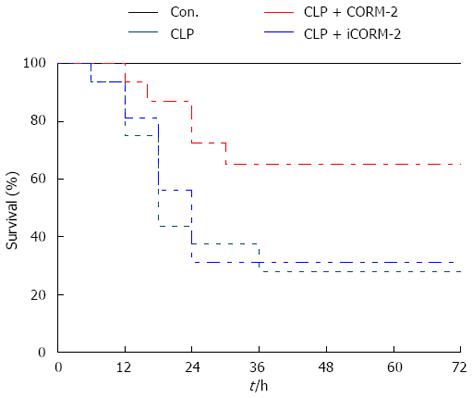Copyright
©2014 Baishideng Publishing Group Co.
World J Gastroenterol. Mar 28, 2014; 20(12): 3301-3311
Published online Mar 28, 2014. doi: 10.3748/wjg.v20.i12.3301
Published online Mar 28, 2014. doi: 10.3748/wjg.v20.i12.3301
Figure 1 Effect of carbon monoxide-releasing molecule II on survival of septic mice.
Mice were challenged with cecal ligation and puncture (CLP) and treated with tricarbonyldi- chlororuthenium (II) dimer (CORM-2) or iCORM-2 as described in the Methods section. All mice had access to water and food. Mouse survival was monitored six times daily for up to 72 h after surgery. Data are shown as the percentage of surviving animals. The survival rate of mice in the CLP group was substantially low, and was only 42% at 24 h and 26% at 48 h postoperatively. In contrast, the survival rate of mice in the CORM-2 group was significantly increased after the CORM-2 intervention, and was 73% at 24 h and 66% at 48 h postoperatively (P < 0.05). Moreover, at 72 h postoperatively, 66% of the mice were still alive.
- Citation: Liang F, Cao J, Qin WT, Wang X, Qiu XF, Sun BW. Regulatory effect and mechanisms of carbon monoxide-releasing molecule II on hepatic energy metabolism in septic mice. World J Gastroenterol 2014; 20(12): 3301-3311
- URL: https://www.wjgnet.com/1007-9327/full/v20/i12/3301.htm
- DOI: https://dx.doi.org/10.3748/wjg.v20.i12.3301









